Business Accounting Report: Stakeholder and Financial State
VerifiedAdded on 2020/10/22
|9
|2174
|478
Report
AI Summary
This report provides a comprehensive overview of business accounting principles, focusing on break-even analysis, costing techniques, and financial statement analysis. It begins with an introduction to business accounting and its importance in recording, interpreting, and presenting financial data. The report then delves into break-even analysis, explaining its use in evaluating business projects and making investment decisions. It further explores various costing techniques, including standard costing, marginal costing, and absorption costing, and their applications in business decision-making. The report also discusses the significance of final accounts to stakeholders, such as government, investors, creditors, and auditors, and how these accounts provide crucial financial information. Finally, the report evaluates the financial state of a business through the application of financial ratios, including liquidity, solvency, and efficiency ratios, providing insights into the company's performance and financial health. The report concludes by summarizing the key findings and emphasizing the importance of accounting in making informed business decisions.
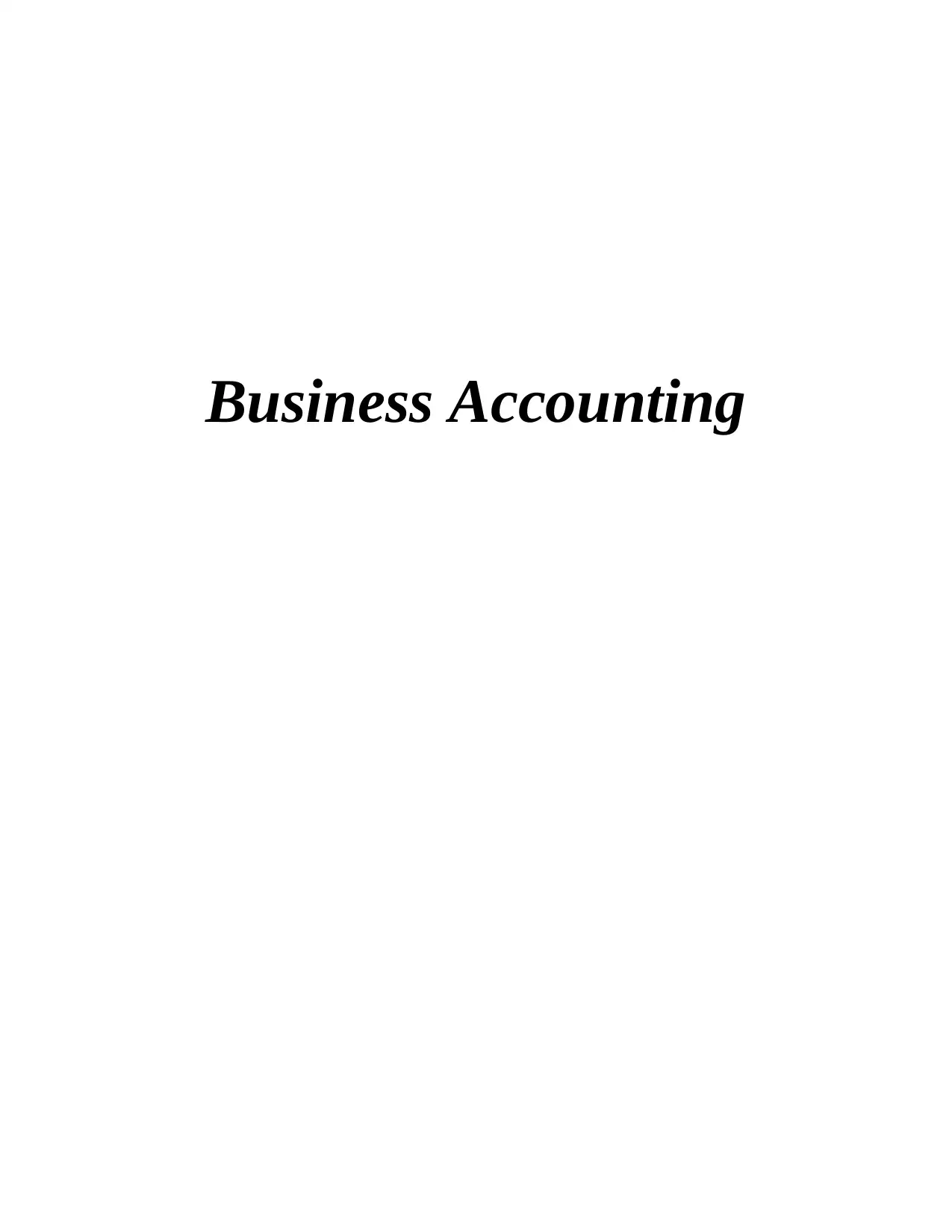
Business Accounting
Paraphrase This Document
Need a fresh take? Get an instant paraphrase of this document with our AI Paraphraser
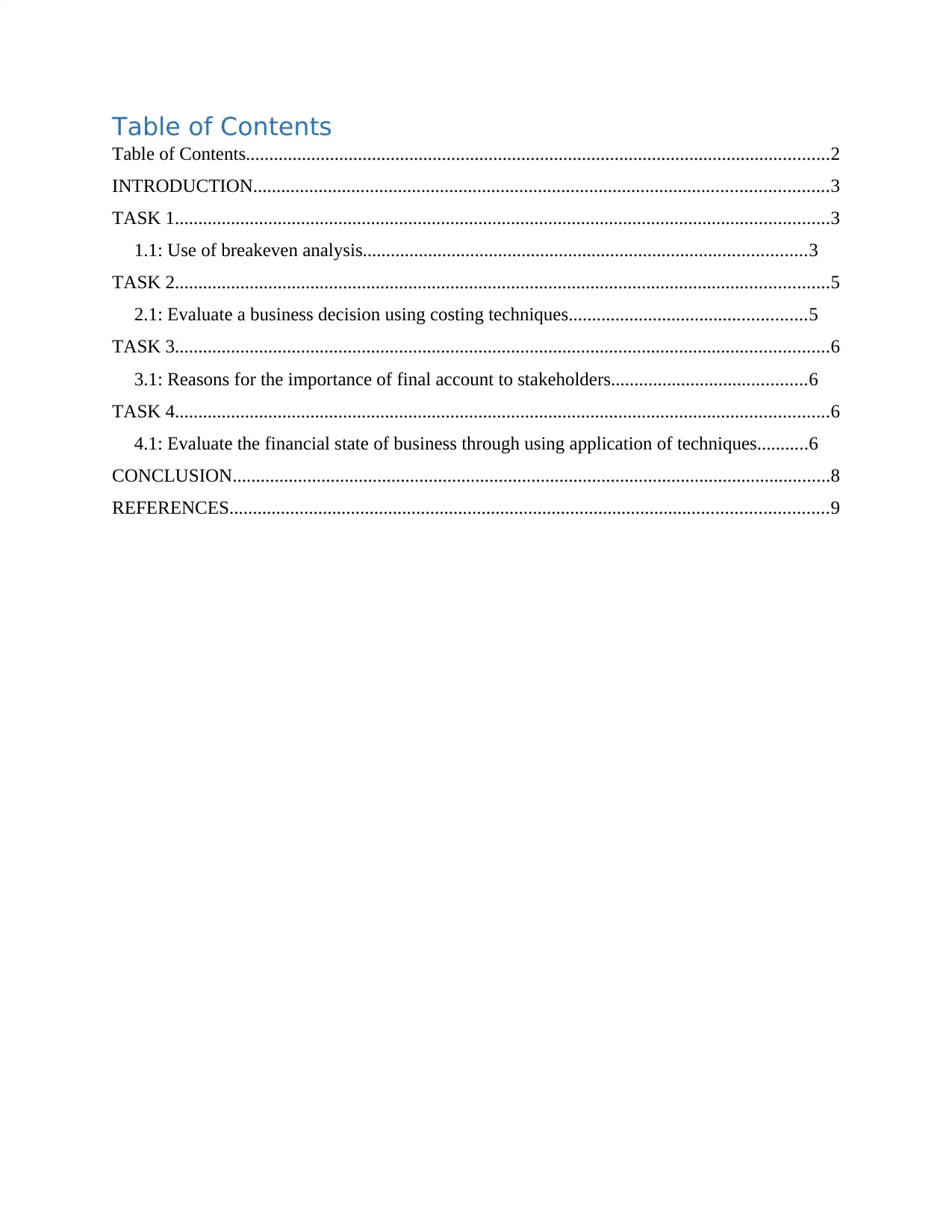
Table of Contents
Table of Contents.............................................................................................................................2
INTRODUCTION...........................................................................................................................3
TASK 1............................................................................................................................................3
1.1: Use of breakeven analysis...............................................................................................3
TASK 2............................................................................................................................................5
2.1: Evaluate a business decision using costing techniques...................................................5
TASK 3............................................................................................................................................6
3.1: Reasons for the importance of final account to stakeholders..........................................6
TASK 4............................................................................................................................................6
4.1: Evaluate the financial state of business through using application of techniques...........6
CONCLUSION................................................................................................................................8
REFERENCES................................................................................................................................9
Table of Contents.............................................................................................................................2
INTRODUCTION...........................................................................................................................3
TASK 1............................................................................................................................................3
1.1: Use of breakeven analysis...............................................................................................3
TASK 2............................................................................................................................................5
2.1: Evaluate a business decision using costing techniques...................................................5
TASK 3............................................................................................................................................6
3.1: Reasons for the importance of final account to stakeholders..........................................6
TASK 4............................................................................................................................................6
4.1: Evaluate the financial state of business through using application of techniques...........6
CONCLUSION................................................................................................................................8
REFERENCES................................................................................................................................9
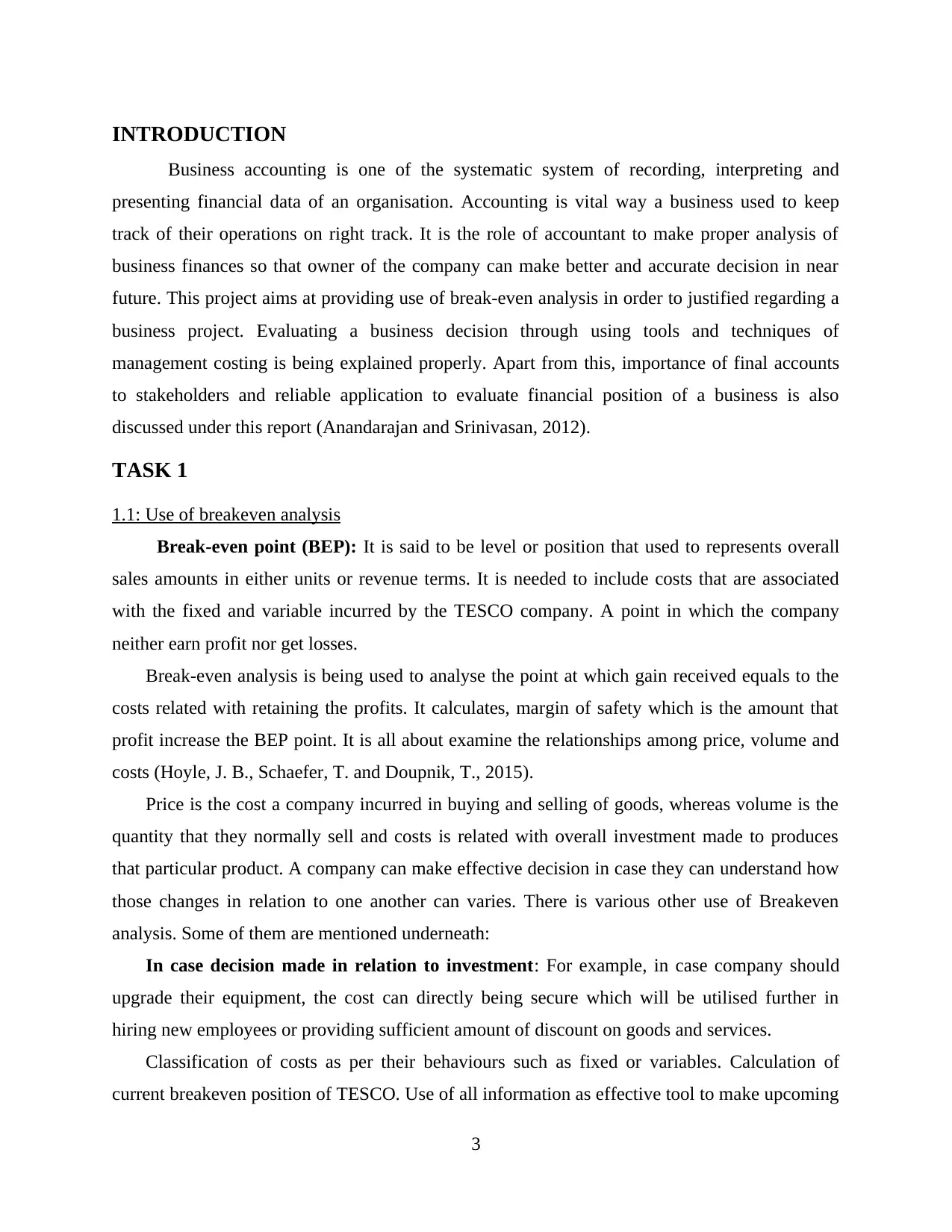
INTRODUCTION
Business accounting is one of the systematic system of recording, interpreting and
presenting financial data of an organisation. Accounting is vital way a business used to keep
track of their operations on right track. It is the role of accountant to make proper analysis of
business finances so that owner of the company can make better and accurate decision in near
future. This project aims at providing use of break-even analysis in order to justified regarding a
business project. Evaluating a business decision through using tools and techniques of
management costing is being explained properly. Apart from this, importance of final accounts
to stakeholders and reliable application to evaluate financial position of a business is also
discussed under this report (Anandarajan and Srinivasan, 2012).
TASK 1
1.1: Use of breakeven analysis
Break-even point (BEP): It is said to be level or position that used to represents overall
sales amounts in either units or revenue terms. It is needed to include costs that are associated
with the fixed and variable incurred by the TESCO company. A point in which the company
neither earn profit nor get losses.
Break-even analysis is being used to analyse the point at which gain received equals to the
costs related with retaining the profits. It calculates, margin of safety which is the amount that
profit increase the BEP point. It is all about examine the relationships among price, volume and
costs (Hoyle, J. B., Schaefer, T. and Doupnik, T., 2015).
Price is the cost a company incurred in buying and selling of goods, whereas volume is the
quantity that they normally sell and costs is related with overall investment made to produces
that particular product. A company can make effective decision in case they can understand how
those changes in relation to one another can varies. There is various other use of Breakeven
analysis. Some of them are mentioned underneath:
In case decision made in relation to investment: For example, in case company should
upgrade their equipment, the cost can directly being secure which will be utilised further in
hiring new employees or providing sufficient amount of discount on goods and services.
Classification of costs as per their behaviours such as fixed or variables. Calculation of
current breakeven position of TESCO. Use of all information as effective tool to make upcoming
3
Business accounting is one of the systematic system of recording, interpreting and
presenting financial data of an organisation. Accounting is vital way a business used to keep
track of their operations on right track. It is the role of accountant to make proper analysis of
business finances so that owner of the company can make better and accurate decision in near
future. This project aims at providing use of break-even analysis in order to justified regarding a
business project. Evaluating a business decision through using tools and techniques of
management costing is being explained properly. Apart from this, importance of final accounts
to stakeholders and reliable application to evaluate financial position of a business is also
discussed under this report (Anandarajan and Srinivasan, 2012).
TASK 1
1.1: Use of breakeven analysis
Break-even point (BEP): It is said to be level or position that used to represents overall
sales amounts in either units or revenue terms. It is needed to include costs that are associated
with the fixed and variable incurred by the TESCO company. A point in which the company
neither earn profit nor get losses.
Break-even analysis is being used to analyse the point at which gain received equals to the
costs related with retaining the profits. It calculates, margin of safety which is the amount that
profit increase the BEP point. It is all about examine the relationships among price, volume and
costs (Hoyle, J. B., Schaefer, T. and Doupnik, T., 2015).
Price is the cost a company incurred in buying and selling of goods, whereas volume is the
quantity that they normally sell and costs is related with overall investment made to produces
that particular product. A company can make effective decision in case they can understand how
those changes in relation to one another can varies. There is various other use of Breakeven
analysis. Some of them are mentioned underneath:
In case decision made in relation to investment: For example, in case company should
upgrade their equipment, the cost can directly being secure which will be utilised further in
hiring new employees or providing sufficient amount of discount on goods and services.
Classification of costs as per their behaviours such as fixed or variables. Calculation of
current breakeven position of TESCO. Use of all information as effective tool to make upcoming
3
⊘ This is a preview!⊘
Do you want full access?
Subscribe today to unlock all pages.

Trusted by 1+ million students worldwide
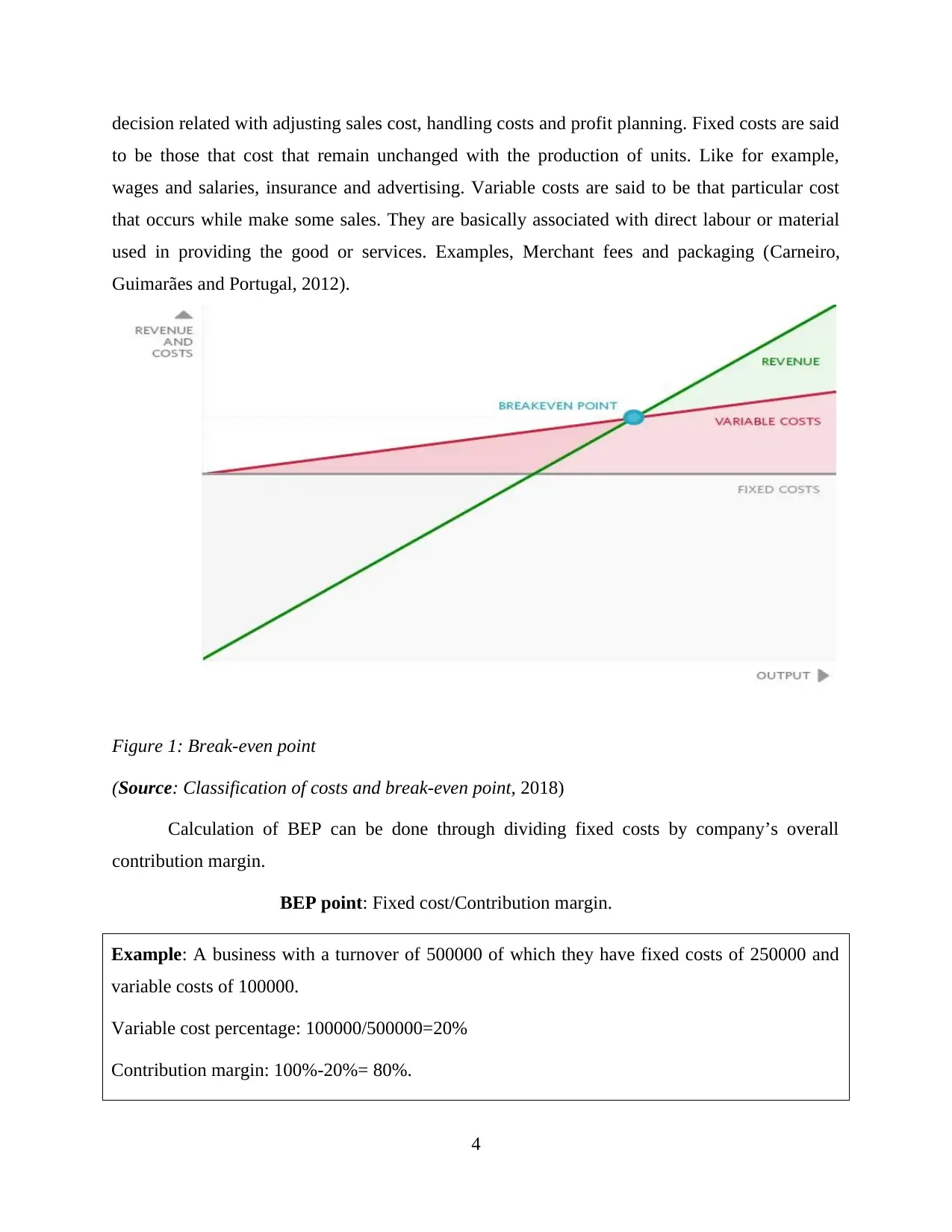
decision related with adjusting sales cost, handling costs and profit planning. Fixed costs are said
to be those that cost that remain unchanged with the production of units. Like for example,
wages and salaries, insurance and advertising. Variable costs are said to be that particular cost
that occurs while make some sales. They are basically associated with direct labour or material
used in providing the good or services. Examples, Merchant fees and packaging (Carneiro,
Guimarães and Portugal, 2012).
Figure 1: Break-even point
(Source: Classification of costs and break-even point, 2018)
Calculation of BEP can be done through dividing fixed costs by company’s overall
contribution margin.
BEP point: Fixed cost/Contribution margin.
Example: A business with a turnover of 500000 of which they have fixed costs of 250000 and
variable costs of 100000.
Variable cost percentage: 100000/500000=20%
Contribution margin: 100%-20%= 80%.
4
to be those that cost that remain unchanged with the production of units. Like for example,
wages and salaries, insurance and advertising. Variable costs are said to be that particular cost
that occurs while make some sales. They are basically associated with direct labour or material
used in providing the good or services. Examples, Merchant fees and packaging (Carneiro,
Guimarães and Portugal, 2012).
Figure 1: Break-even point
(Source: Classification of costs and break-even point, 2018)
Calculation of BEP can be done through dividing fixed costs by company’s overall
contribution margin.
BEP point: Fixed cost/Contribution margin.
Example: A business with a turnover of 500000 of which they have fixed costs of 250000 and
variable costs of 100000.
Variable cost percentage: 100000/500000=20%
Contribution margin: 100%-20%= 80%.
4
Paraphrase This Document
Need a fresh take? Get an instant paraphrase of this document with our AI Paraphraser
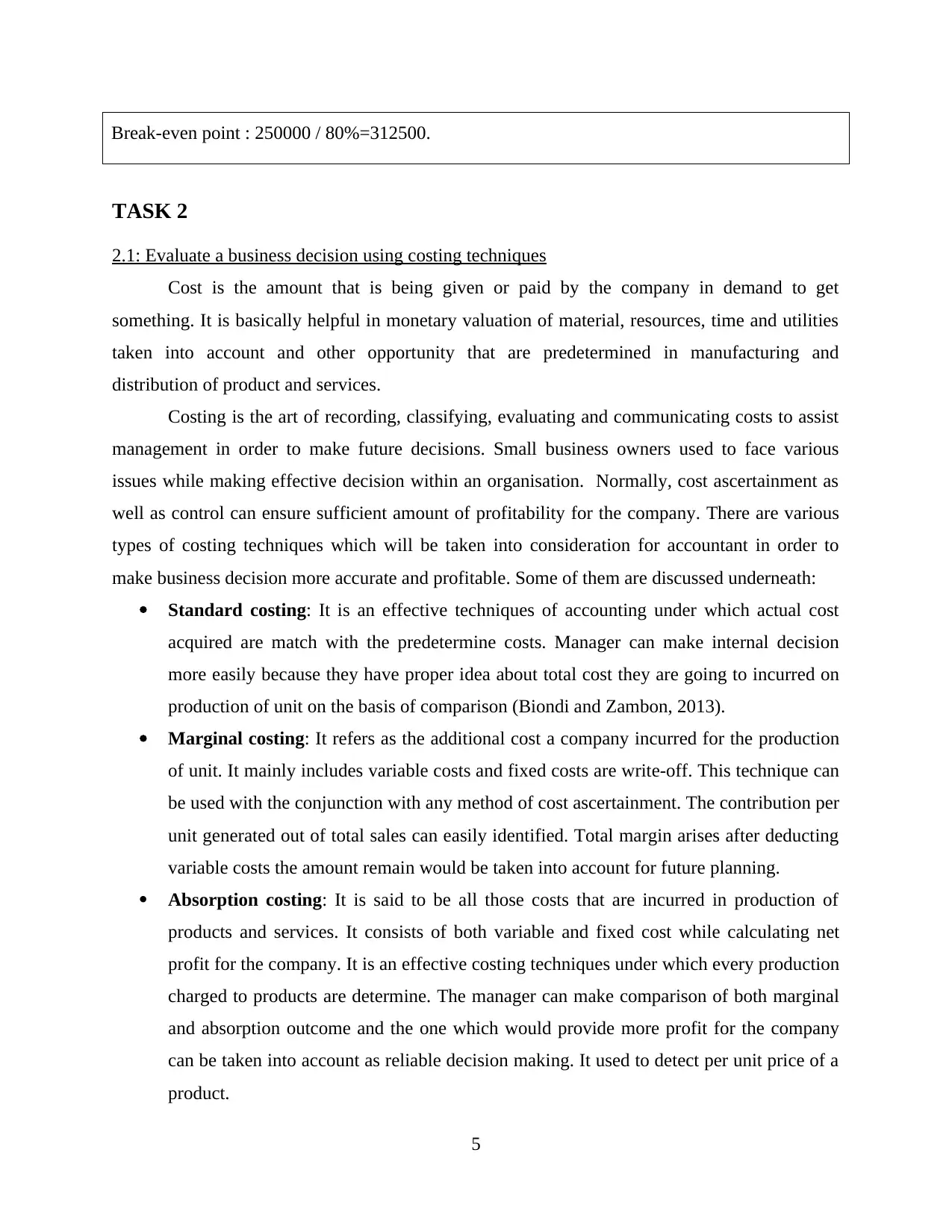
Break-even point : 250000 / 80%=312500.
TASK 2
2.1: Evaluate a business decision using costing techniques
Cost is the amount that is being given or paid by the company in demand to get
something. It is basically helpful in monetary valuation of material, resources, time and utilities
taken into account and other opportunity that are predetermined in manufacturing and
distribution of product and services.
Costing is the art of recording, classifying, evaluating and communicating costs to assist
management in order to make future decisions. Small business owners used to face various
issues while making effective decision within an organisation. Normally, cost ascertainment as
well as control can ensure sufficient amount of profitability for the company. There are various
types of costing techniques which will be taken into consideration for accountant in order to
make business decision more accurate and profitable. Some of them are discussed underneath:
Standard costing: It is an effective techniques of accounting under which actual cost
acquired are match with the predetermine costs. Manager can make internal decision
more easily because they have proper idea about total cost they are going to incurred on
production of unit on the basis of comparison (Biondi and Zambon, 2013).
Marginal costing: It refers as the additional cost a company incurred for the production
of unit. It mainly includes variable costs and fixed costs are write-off. This technique can
be used with the conjunction with any method of cost ascertainment. The contribution per
unit generated out of total sales can easily identified. Total margin arises after deducting
variable costs the amount remain would be taken into account for future planning.
Absorption costing: It is said to be all those costs that are incurred in production of
products and services. It consists of both variable and fixed cost while calculating net
profit for the company. It is an effective costing techniques under which every production
charged to products are determine. The manager can make comparison of both marginal
and absorption outcome and the one which would provide more profit for the company
can be taken into account as reliable decision making. It used to detect per unit price of a
product.
5
TASK 2
2.1: Evaluate a business decision using costing techniques
Cost is the amount that is being given or paid by the company in demand to get
something. It is basically helpful in monetary valuation of material, resources, time and utilities
taken into account and other opportunity that are predetermined in manufacturing and
distribution of product and services.
Costing is the art of recording, classifying, evaluating and communicating costs to assist
management in order to make future decisions. Small business owners used to face various
issues while making effective decision within an organisation. Normally, cost ascertainment as
well as control can ensure sufficient amount of profitability for the company. There are various
types of costing techniques which will be taken into consideration for accountant in order to
make business decision more accurate and profitable. Some of them are discussed underneath:
Standard costing: It is an effective techniques of accounting under which actual cost
acquired are match with the predetermine costs. Manager can make internal decision
more easily because they have proper idea about total cost they are going to incurred on
production of unit on the basis of comparison (Biondi and Zambon, 2013).
Marginal costing: It refers as the additional cost a company incurred for the production
of unit. It mainly includes variable costs and fixed costs are write-off. This technique can
be used with the conjunction with any method of cost ascertainment. The contribution per
unit generated out of total sales can easily identified. Total margin arises after deducting
variable costs the amount remain would be taken into account for future planning.
Absorption costing: It is said to be all those costs that are incurred in production of
products and services. It consists of both variable and fixed cost while calculating net
profit for the company. It is an effective costing techniques under which every production
charged to products are determine. The manager can make comparison of both marginal
and absorption outcome and the one which would provide more profit for the company
can be taken into account as reliable decision making. It used to detect per unit price of a
product.
5

TASK 3
3.1: Reasons for the importance of final account to stakeholders
Stakeholder: It refers to as a person, group or firm that has interest within an organisation.
They can be affected by decisions, objectives and plan those are set by the company. It consists
of creditors, directors, employees, government and other agencies. As they are important part of
an organisation so that each and every information must be shared among every stakeholder.
Similarly, every final accounts detail that is prepared by the accountant must be in the knowledge
of stakeholders (Palepu, Healy and Peek, 2013). These reports are the statements which are
greatest significance to the lot of external or internal parties. Some of them are:
Government: They are regulatory bodies that provide specific rules and regulation for
the business to operate in proper manner. It would assist them in generating tax revenue
to the government so that they can maintain effective growth rate for long time.
Investors: It is known as financer for the company. In order to make any capital related
investment, they need to check company financial statements that consists of profit and
loss account, balance sheet as so on. It will be reliable for them to take funding decisions
more effectively.
Creditors: The have done their unpaid diligence on the underlying business by
discharging capital to the borrowers. Because the creditors want to safeguard the
borrower has the ability to pay back the loan. Financial record issued to them to relay
data regarding past company performance and fund position. It will assist them to make
plan for the future growth and stability.
Auditors: It has been found that auditors used to provides proper assurance to the
investors as well as creditors that company capital are kept effectively. They would also
assist that all the matter must be present accurately so that decisions can be made
accurately.
TASK 4
4.1: Evaluate the financial state of business through using application of techniques
In every business organisation, it is essential to make proper analyse of TESCO company
overall performance. The use of financial ratio is a time-tested method which is used for the
purpose of analysing business performance. Ratio analysis is one of the largely used measure
6
3.1: Reasons for the importance of final account to stakeholders
Stakeholder: It refers to as a person, group or firm that has interest within an organisation.
They can be affected by decisions, objectives and plan those are set by the company. It consists
of creditors, directors, employees, government and other agencies. As they are important part of
an organisation so that each and every information must be shared among every stakeholder.
Similarly, every final accounts detail that is prepared by the accountant must be in the knowledge
of stakeholders (Palepu, Healy and Peek, 2013). These reports are the statements which are
greatest significance to the lot of external or internal parties. Some of them are:
Government: They are regulatory bodies that provide specific rules and regulation for
the business to operate in proper manner. It would assist them in generating tax revenue
to the government so that they can maintain effective growth rate for long time.
Investors: It is known as financer for the company. In order to make any capital related
investment, they need to check company financial statements that consists of profit and
loss account, balance sheet as so on. It will be reliable for them to take funding decisions
more effectively.
Creditors: The have done their unpaid diligence on the underlying business by
discharging capital to the borrowers. Because the creditors want to safeguard the
borrower has the ability to pay back the loan. Financial record issued to them to relay
data regarding past company performance and fund position. It will assist them to make
plan for the future growth and stability.
Auditors: It has been found that auditors used to provides proper assurance to the
investors as well as creditors that company capital are kept effectively. They would also
assist that all the matter must be present accurately so that decisions can be made
accurately.
TASK 4
4.1: Evaluate the financial state of business through using application of techniques
In every business organisation, it is essential to make proper analyse of TESCO company
overall performance. The use of financial ratio is a time-tested method which is used for the
purpose of analysing business performance. Ratio analysis is one of the largely used measure
6
⊘ This is a preview!⊘
Do you want full access?
Subscribe today to unlock all pages.

Trusted by 1+ million students worldwide

that rate at which TESCO is turning over their assets and liabilities accordingly. This tool
provides specific information about the financial health position of the company. It consists you
to make comparison of business against various standards. For this purpose, they need to make
use of various ratios such as:
Liquidity ratios: It is used to analyse company liquidity position, whether they would
have sufficient amount of capital for the investments. It consists of various types such as:
Current ratio.
Quick ratio.
Liquidity/Financial Health
2016-
02
2017-
02
2018-
02
Current Ratio 0.75 0.79 0.71
Quick Ratio 0.59 0.64 0.52
From the above analysis, it has been found that current ratio of Tesco company is getting
increase every year. In 2018, the current ratio is 0.71 which is less as compare to other.
Similarly, quick ratios are also providing same kind of results to the manager.
Solvency ratios: One of the best ways to determine the solvency sign manager need to
examine gearing ratios. It is calculated through allocating loans and bank overdrafts by equity.
The more ratios mean vulnerability position of the company is also more. Most lenders used to
refuse further, finance where goes increasing with 50% (Miller-Nobles, Mattison and
Matsumura, 2016).
Efficiency ratio: This particular ratio is basically used to determine overall efficiency of the
company. It can calculate the total turnover of receivables, repayment of debts, quantity and
usage of equity. It used to measure the company’s ability to make use of their assets and manage
their liability properly. Some of the crucial efficiency ratios are mentioned underneath:
Inventory turnover ratio
Asset turnover ratio
Receivable turnover ratio
Receivables Turnover 54.43 56.74 38.88
Inventory Turnover 19.15 22.41 23.73
Fixed Assets Turnover 2.84 3.11 3.14
Asset Turnover 1.24 1.24 1.27
From the above ratios, it has been seen that receivable is rotating 54.43 and 56.74. while
inventory turnover is repeating more quickly in every year. The company mainly used to prepare
7
provides specific information about the financial health position of the company. It consists you
to make comparison of business against various standards. For this purpose, they need to make
use of various ratios such as:
Liquidity ratios: It is used to analyse company liquidity position, whether they would
have sufficient amount of capital for the investments. It consists of various types such as:
Current ratio.
Quick ratio.
Liquidity/Financial Health
2016-
02
2017-
02
2018-
02
Current Ratio 0.75 0.79 0.71
Quick Ratio 0.59 0.64 0.52
From the above analysis, it has been found that current ratio of Tesco company is getting
increase every year. In 2018, the current ratio is 0.71 which is less as compare to other.
Similarly, quick ratios are also providing same kind of results to the manager.
Solvency ratios: One of the best ways to determine the solvency sign manager need to
examine gearing ratios. It is calculated through allocating loans and bank overdrafts by equity.
The more ratios mean vulnerability position of the company is also more. Most lenders used to
refuse further, finance where goes increasing with 50% (Miller-Nobles, Mattison and
Matsumura, 2016).
Efficiency ratio: This particular ratio is basically used to determine overall efficiency of the
company. It can calculate the total turnover of receivables, repayment of debts, quantity and
usage of equity. It used to measure the company’s ability to make use of their assets and manage
their liability properly. Some of the crucial efficiency ratios are mentioned underneath:
Inventory turnover ratio
Asset turnover ratio
Receivable turnover ratio
Receivables Turnover 54.43 56.74 38.88
Inventory Turnover 19.15 22.41 23.73
Fixed Assets Turnover 2.84 3.11 3.14
Asset Turnover 1.24 1.24 1.27
From the above ratios, it has been seen that receivable is rotating 54.43 and 56.74. while
inventory turnover is repeating more quickly in every year. The company mainly used to prepare
7
Paraphrase This Document
Need a fresh take? Get an instant paraphrase of this document with our AI Paraphraser

financial reports that are based on cumulatively indicate the overall strength and position of an
organisation. It comprises of various statements such as income, balance sheet and cash flow.
CONCLUSION
From the above project report, it has been concluded that business accounting is an
important way to analyse financial position of the company. Use of breakeven analysis and
techniques of management costing to detect the current situation of an organisation. Evaluation
of important of final account to stakeholders and techniques of ratios analysis is use effectively
to get more reliable outcomes for the company.
8
organisation. It comprises of various statements such as income, balance sheet and cash flow.
CONCLUSION
From the above project report, it has been concluded that business accounting is an
important way to analyse financial position of the company. Use of breakeven analysis and
techniques of management costing to detect the current situation of an organisation. Evaluation
of important of final account to stakeholders and techniques of ratios analysis is use effectively
to get more reliable outcomes for the company.
8

REFERENCES
Books and Journal:
Anandarajan, M., Anandarajan, A. and Srinivasan, C.A. eds., 2012. Business intelligence
techniques: a perspective from accounting and finance. Springer Science & Business
Media.
Biondi, Y. and Zambon, S. eds., 2013. Accounting and business economics: Insights from
national traditions. Routledge.
Carneiro, A., Guimarães, P. and Portugal, P., 2012. Real wages and the business cycle:
Accounting for worker, firm, and job title heterogeneity. American Economic Journal:
Macroeconomics. 4(2). pp.133-52.
Hoyle, J. B., Schaefer, T. and Doupnik, T., 2015. Advanced accounting. McGraw Hill.
Miller-Nobles, T. L., Mattison, B. and Matsumura, E. M., 2016. Horngren's Financial &
Managerial Accounting: The Managerial Chapters. Pearson.
Palepu, K. G., Healy, P. M. and Peek, E., 2013. Business analysis and valuation: IFRS edition.
Cengage learning.
Online
Classification of costs and break-even point, 2018. [Online]. Available through:
<https://www.digitbooks.com.au/using-breakeven-analysis-make-better-decisions/>.
9
Books and Journal:
Anandarajan, M., Anandarajan, A. and Srinivasan, C.A. eds., 2012. Business intelligence
techniques: a perspective from accounting and finance. Springer Science & Business
Media.
Biondi, Y. and Zambon, S. eds., 2013. Accounting and business economics: Insights from
national traditions. Routledge.
Carneiro, A., Guimarães, P. and Portugal, P., 2012. Real wages and the business cycle:
Accounting for worker, firm, and job title heterogeneity. American Economic Journal:
Macroeconomics. 4(2). pp.133-52.
Hoyle, J. B., Schaefer, T. and Doupnik, T., 2015. Advanced accounting. McGraw Hill.
Miller-Nobles, T. L., Mattison, B. and Matsumura, E. M., 2016. Horngren's Financial &
Managerial Accounting: The Managerial Chapters. Pearson.
Palepu, K. G., Healy, P. M. and Peek, E., 2013. Business analysis and valuation: IFRS edition.
Cengage learning.
Online
Classification of costs and break-even point, 2018. [Online]. Available through:
<https://www.digitbooks.com.au/using-breakeven-analysis-make-better-decisions/>.
9
⊘ This is a preview!⊘
Do you want full access?
Subscribe today to unlock all pages.

Trusted by 1+ million students worldwide
1 out of 9
Related Documents
Your All-in-One AI-Powered Toolkit for Academic Success.
+13062052269
info@desklib.com
Available 24*7 on WhatsApp / Email
![[object Object]](/_next/static/media/star-bottom.7253800d.svg)
Unlock your academic potential
Copyright © 2020–2025 A2Z Services. All Rights Reserved. Developed and managed by ZUCOL.





